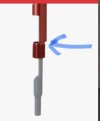I don't know about you but I measure OAL with calipers.
This isn't a Hornady thing but a term usage issue. I bring it up because I see a growing number of reloaders (new apparently) who think OAL means touch length of cartridge.
Like they can't set book OAL without measuring land relationship, or they think they need to load into lands, or a certain distance from lands.
Maybe the merchandising has them thinking that is what everyone has to do.
In reality, if you think about it, most hunting cartridge reloaders never actually need to measure or know their land relationship, nor touch length.
They're far better to focus on full seating testing, and simply reproduce tested best CBTO.
Whatever land relationship that is initially, or later, -doesn't really matter.

